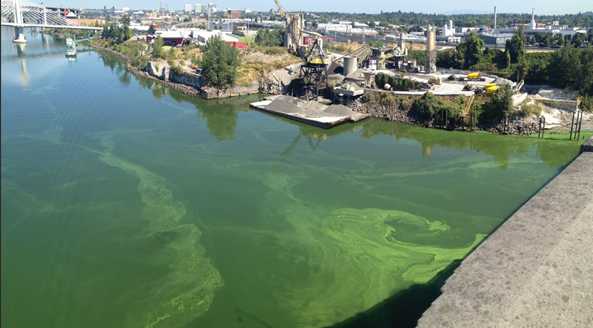Harmful Algal Blooms & the Environment
Factors that Promote Growth of Harmful Algal Blooms

HAB in downtown Portland, Oregon. Credit: Photo courtesy of the Oregon Public Health.
A HAB can occur in fresh, marine (salt), and brackish (a mixture of fresh and salt) water bodies around the world 1-4. HABs have occurred in every region of the United States 5. Over 50% of states report a HAB every year in a freshwater body, and all coastal states report HABs in marine waters 6.
A HAB is caused by different types of organisms called phytoplankton, some of which can produce toxins 7,8. Cyanobacteria, a type of phytoplankton also known as blue-green algae, are often the cause of algal blooms in fresh water and occasionally in marine water 1,2. Dinoflagellates, a different type of phytoplankton, are the most common cause of HABs in marine waters. Diatoms, another type of phytoplankton, have also been found in coastal waters, such as the brackish waters of estuaries 3. Various factors can cause rapid growth, or blooming of these organisms, including:
- Increases in nutrient levels (for example phosphorus and nitrates) from fertilizer run-off from residences and agricultural lands, sewage discharges, and run-off from urban areas and industrial facilities
- Changes in nutrient levels associated with ocean upwelling (El Niño, El Niña)
- Low water flows, such as those associated with drought
- Changes in water temperature, particularly increases in temperature
- Changes in chemical factors such as pH or turbidity
- Changes in ocean currents
- Changes in the local ecology (how organisms interact with each other)
Climate change might increase the occurrence, severity, and impact of HABs in fresh, marine, and brackish waters. For example, warming temperatures in Lake Erie have resulted in more extensive blooms of the cyanobacteria Microcystis aeruginosa, that last into the early winter months. In the past several years, HABs have been observed with increasing frequency and in more locations in the United States. The National Centers for Coastal Ocean Science (NCCOS) is working to monitor and address the impacts of climate change on HABs. HABs have been documented and monitored regionally by the NCCOS in the Gulf of Mexico, the Great Lakes, the Northeast, the Pacific Coast, the Southeast, and the Caribbean/Pacific Islands.
References
- Lopez CB, Jewett, EB, Dortch Q, Walton BT, Hudnell HK. Scientific assessment of freshwater harmful algal blooms. [PDF - 78 pages] Washington DC: Interagency Working Group on Harmful Algal Blooms, Hypoxia, and Human Health of the Join Subcommittee on Ocean Science and Technology. Washington DC; 2008.
- Chorus I, Bartram J, eds. Toxic Cyanobacteria in water: A guide to their public health consequences, monitoring and management. [PDF - 400 pages] London, United Kingdom: World Health Organization; Routledge, London; 1999.
- Lopez CB, Dortch Q, Jewett EB, Garrison D. Scientific assessment of marine harmful algal blooms. [PDF - 72 pages] Washington DC: Interagency Working Group on Harmful Algal Blooms, Hypoxia, and Human Health of the Join Subcommittee on Ocean Science and Technology. Washington DC; 2008.
- Anderson DM. Approaches to monitoring, control and management of harmful algal blooms (HABs). Ocean and Coastal Manag. 2009;52(7):342-347
- Woods Hole Oceanographic Institute. Distribution of HABs in the U.S. 2012.
- Resource Media, National Wildlife Federation. 2014 harmful algal bloom state survey: Summary of results and recommendations. Resource Media: Toxic Algae News. 2014.
- Hudnell HK. The state of U.S. freshwater harmful algal blooms assessments, policy and legislation. Toxicon. 2010;55(5):1024-34.
- Kite-Powell HL , Fleming LE, Backer LC, Faustman E, Hoagland P, Tsuchiya A, Younglove L, Wilcox BA, Gast R. Linking the oceans to public health: Where is the "human health" in "oceans and human health?" Mini-Monograph: Research in Oceans and Human Health. Environ Health. 2008;7(Suppl 2):S6.
- Page last reviewed: May 27, 2016
- Page last updated: May 27, 2016
- Content source:


 ShareCompartir
ShareCompartir